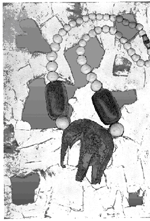 Kim Echlin
Kim Echlin
Kim Echlin's first novel, Elephant Winter, introduced us to a uniquely different creative imagination at work in the fiction field. Now, in her second novel, she has continued to surprise us¨and enchant us. For Dagmar's Daughter is an enchanted tale, and must be approached as such. To truly savour the novel, we need to give our trust to its teller and allow ourselves to be led where she leads us, in the open-hearted spirit of children who are eager to be led into a fairy world. The novel unfolds a mythic tale, with ties to two ancient myths, the story of Demeter and Persephone the most often-told and familiar. Demeter is the earth goddess and immortal. Her daughter, Persephone, is stolen by Pluto, Prince of Hades, and taken to the underworld. Demeter follows and brings her back, but because Persephone has eaten one seed from the pomegranate she was carrying when Pluto abducted her, she is doomed forever to spend a part of every year in Hades. The book's epigraph from The Descent of Inanna, a Sumerian story of 2000 B.C., opens the door to an even more ancient myth, that of the powerful goddess, Inanna, who braved the underworld to establish her power (and by her example the power of women) and succeeded.
Echlin's homage to the myths begins with Moll, a motherless girl who bore and then drowned a dead baby, hid in a ship that was shipwrecked in the gulf of St. Lawrence and "after two days and a night she washed up a blue meagre hag on the shore of a little island" called Millstone Nether. Moll is a presiding spirit, and the character related to Inanna, for her near-drowning has been her descent to the underworld: "She was whirled and spun below and divested of what she once was ...She became in the lowest deep, a lower deep." Always hiding in the woods, she was sometimes an agent of light and healing, more often of darkness and death, but always hovering over the tale, a powerful dynamic in its telling. She found the body of Meggie Dob's mother washed up on the shore of the island that had first been settled by "merry-begots and hangashores, sleveens and slawmeens," and all of them musicians; "Millstone Nether's impractical claim for itself was music." Making their own instruments out of branches and boards, they were favoured by fate with instruments washed up on their shores, one time a barrel of fiddles and another of whistles. Moll herself drew strange music out of a bronze pot she had salvaged from the sea.
The developing lineage of three generations of heroically strong women, begins with Norea Nolan in an impoverished Irish village, desperate to escape. She stole the shoes from her dead mother's feet and walked to Dublin, where she stowed away on a ship bound for the New World and the island of Millstone Nether.
 Books in Canada May, 1997 cover illustration of Elephant Winter
Books in Canada May, 1997 cover illustration of Elephant Winter
Norea was beguiled by the music made by Rory, a young man of the village, but Rory died in the great flu epidemic, and Norea gave birth to Dagmar who from the beginning had a strange gift: plants grew if she touched them, and whole orchards and gardens appeared; storms occurred if she was unhappy, and harvests were abundant if she smiled. She is the Demeter figure, and her daughter Nyssa, the Persephone, is irrevocably but not permanently linked to Moll and her fearsome power.
The tale is anchored to a reality we can recognize by its music¨the music of Donal Dob, the son of Meggie, and his friend, Colin Cane. In a complicated courtship dance of leaving and return, acceptance, love and loss, and always their obsessive devotion to the perfectibility of their music, they ensnare both Dagmar and Nyssa whose music is likewise magic and perfectly matched to Donal's. The end brings with it redemption as the whole village celebrates the inevitable reunion of Nyssa and Donal: "The Millstone Nether people called for more and played together the old reels and jigs and strathspeys. They were happy to hear again the playing of Nyssa, who went her own way and Donal, who went with her, to hear the sounds those two alone could wring from fiddle and double bass."
Dagmar's Daughter is anything but an easy novel to read and understand, but it rewards the effort, not only for the depth of its story and its ancient undertones, but for its grounding in an unshakeable reverence for art: "It was a young island where art and life went hand in hand....On the island it was thought that life could not be beautiful without art, nor art flourish without life. When Norea gave her grandchild Nyssa a fiddle she said, "This little fiddle is fashioned from the suffering of the world. Are you worthy of it?" At the last, Nyssa proved herself worthy.
This book should really be read aloud. It is a story begging to be heard, with all the variations of tone and expression that a voice could bring to it. But even experienced only as the words on the page, it is hauntingly memorable. ˛